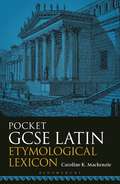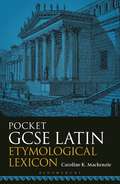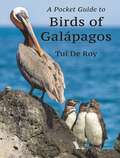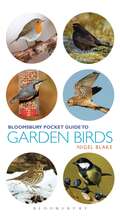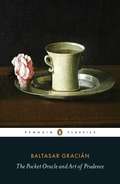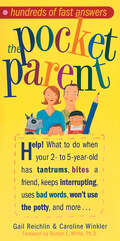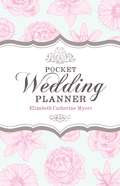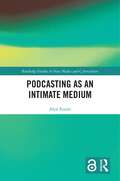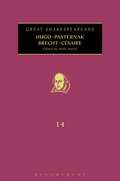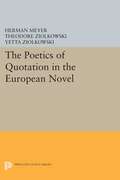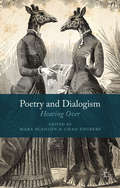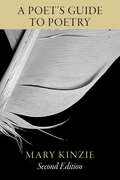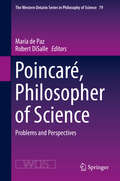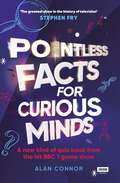- Table View
- List View
A Pocket Essential Short Introduction to Religion (Short History Ser.)
by Gordon KerrDuring this time of conflict and suspicion, it is perhaps more important than ever to understand the beliefs and philosophies of other cultures.A Short History of Religion provides a useful guide to the world's most popular religions - Christianity, Islam, Buddhism, Judaism and Hinduism - describing their origins and history, beliefs, worship and sacred writings, but also investigates many of the smaller and lesser known religions as well as newer movements such as Scientology, Wicca and Raëlism.Praise for Gordon Kerr'Factual and even-handed, Kerr presents a fair-minded introduction of basic Chinese history' - Booklist'Thoroughly rewarding' - Travelmag'Informative, fascinating and extremely well-researched...Gordon Kerr's book is a mini masterpiece' - ABC Brisbane
Pocket GCSE Latin Etymological Lexicon
by Caroline K. MackenzieAn essential tool for the learning of Latin, based around the GCSE word lists of OCR and WJEC. Each Latin word is translated and given a set of derivatives, some common and others less so. Space is given for readers to annotate as they learn - and note other derivatives they may come across too!A concise introduction and a glossary of Latin in common usage combine to make this a vade mecum for all learners of Latin as well as cruciverbalists. The text is imaginatively punctuated by 20 illustrations by Amanda Short.
Pocket GCSE Latin Etymological Lexicon
by Caroline K. MackenzieAn essential tool for the learning of Latin, based around the GCSE word lists of OCR and WJEC. Each Latin word is translated and given a set of derivatives, some common and others less so. Space is given for readers to annotate as they learn - and note other derivatives they may come across too!A concise introduction and a glossary of Latin in common usage combine to make this a vade mecum for all learners of Latin as well as cruciverbalists. The text is imaginatively punctuated by 20 illustrations by Amanda Short.
A Pocket Guide to Birds of Galápagos
by Tui De RoyA compact, richly illustrated photographic field guide to all of the birds of Galápagos, from renowned photographer and writer Tui De RoyA lifelong resident of Galápagos, Tui De Roy has been observing, studying, and photographing the islands’ astonishing birdlife for sixty years. In A Pocket Guide to Birds of Galápagos, she distills everything she has learned to create a one-of-a-kind field guide that every birder visiting the archipelago will want to carry with them wherever they go.A compact yet comprehensive combination of field guide and natural history, the book features more than 600 of De Roy’s superb photographs and is packed with detailed, easy-to-access information in bullet-point format. Every resident bird species is fully described and abundantly illustrated, showing different aspects of their life cycle, habitat, and behavior. And the islands’ most iconic bird group—Darwin’s Finches—is given special attention. With precise descriptions including plumage and beak variations, the book corrects many common identification errors about this group.Unique in design and content, A Pocket Guide to Birds of Galápagos is a must-have for all wildlife enthusiasts traveling to this fabled archipelago—and anyone who wants to better understand its spectacular birds.A compact yet comprehensive photographic identification guideCovers all resident species and frequent migrantsFeatures more than 600 of Tui De Roy’s superb color photographsIncludes distribution maps and easy-to-find information for identifying and understanding each species, including life cycles, habits, range, and conservation status
Pocket Guide to Fluid, Electrolyte, and Acid-Base Balance - E-Book (Nursing Pocket Guides)
by Ursula Heitz Mima M. HorneWith its concise, user-friendly outline format, this handy pocket guide is the indispensable consultant for fluid, electrolyte, and acid-base disturbances and how they relate to patient care. Readers will discover pathophysiology, assessment, diagnostic tests, collaborative management, and nursing diagnoses and interventions reviewed in a logical, consistent, and easy-to-read manner.Helps readers identify a patient's specific imbalance and understand the required nursing care Provides the ability to look up a diagnosis and learn what fluid, electrolyte, or acid-base disturbances are associated with that diagnosis Includes patient-family teaching guidelines with clear instructions to give the patient and family regarding care for the condition Provides pediatric and geriatric information to help users understand the variations within these special patient populationsCompares different types of parenteral and enteral feedings, along with nursing implications Contains expanded and updated relevant IV therapy and pharmacology Features updated content throughout with current literature and research findings, such as most current blood pressure guidelines from the U.S. Department of Health and Human Services
Pocket Guide To Garden Birds (Pocket Guides)
by Nigel BlakeThis compact title is an essential guide to every aspect of the subject, from when and what to feed the birds to building bird tables and nest boxes and planting a garden that will provide nesting, feeding and roosting places. There is also an ID guide to 80 of the most common garden bird species, including the familiar Chaffinch and Blue Tit and more unusual visitors such as Brambling, Redstart and Tawny Owl.This book is as visually impressive as it is easy to use, with many stunning full-page and double-page images to support the authoritative text. Printed on quality paper, the paperback format with flaps adds to the book's durability in the field and provides built-in page-markers for quick reference.
Pocket Guide To Garden Birds (Pocket Guides)
by Nigel BlakeThis compact title is an essential guide to every aspect of the subject, from when and what to feed the birds to building bird tables and nest boxes and planting a garden that will provide nesting, feeding and roosting places. There is also an ID guide to 80 of the most common garden bird species, including the familiar Chaffinch and Blue Tit and more unusual visitors such as Brambling, Redstart and Tawny Owl.This book is as visually impressive as it is easy to use, with many stunning full-page and double-page images to support the authoritative text. Printed on quality paper, the paperback format with flaps adds to the book's durability in the field and provides built-in page-markers for quick reference.
A Pocket Guide to Sharks of the World: Second Edition (Wild Nature Press)
by Dr. David A. Ebert Marc Dando Dr. Sarah FowlerAn updated and comprehensive guide identifying all of the world's sharksSharks are some of the most misunderstood animals on the planet. We still have a lot to learn about these fascinating creatures, which are more seriously threatened with extinction and in greater need of conservation and management than any other major group of vertebrates.A Pocket Guide to Sharks of the World is the only field guide to identify, illustrate, and describe every known shark species. Its compact format makes it handy for many situations, including recognizing living species, fishery catches, or parts sold at markets. This expanded second edition presents lavish images, details on newly discovered species, and updated text throughout. The book contains useful sections on identifying shark teeth and the shark fins most commonly encountered in the fin trade, and takes a look at shark biology, ecology, and conservation. A Pocket Guide to Sharks of the World will be an essential resource and definitive reference for years to come.An updated guide to all of the world’s sharksEach species is illustrated and describedHandy, compact format with concise textUseful sections on the identification of shark teeth and fins
The Pocket Instructor: 50 Exercises for the College Classroom (Skills for Scholars #6)
by Amanda Irwin Wilkins and Keith ShawFifty easy-to-deploy active learning exercises for teaching academic writing in any fieldThe Pocket Instructor: Writing offers fifty practical exercises for teaching students the core elements of successful academic writing. The exercises—created by faculty from a broad range of disciplines and institutions—are organized along the arc of a writing project, from brainstorming and asking analytical questions to drafting, revising, and sharing work with audiences outside traditional academia. They present students with engaging intellectual challenges to work through together, arriving at generalizable lessons that transfer well across the humanities, social sciences, and natural sciences.Students will learn to articulate a thoughtful question, develop a persuasive thesis, analyze complex evidence, and engage responsibly with sources. The Pocket Instructor: Writing offers teachers concrete ideas about how to cultivate habits of radical revision and create a classroom community with an ethos of trust where students learn to give meaningful feedback. Written for both novice and veteran instructors, this essential guide will benefit faculty in any field who hope to improve student writing in their courses.Key features:• Exercises by experienced faculty from a wide range of disciplines and institutions• Step-by-step instructions with instructor insights for each exercise• A &“Writing Lexicon&” for terms such as motive, thesis, analysis, evidence, and method• Guidance for avoiding plagiarism• Index and cross-references to aid in course planning
The Pocket Instructor: 101 Exercises for the College Classroom
by Diana Fuss William A. GleasonThis is the first comprehensive collection of hands-on, active learning exercises for the college literature classroom, offering ideas and inspiration for new and veteran teachers alike.These 101 surefire lesson plans present creative and interactive activities to get all your students talking and learning, from the first class to final review. Whether you are teaching majors or nonmajors, genres or periods, canonical or noncanonical literature, medieval verse or the graphic novel, this volume provides practical and flexible exercises for creating memorable learning experiences. Help students learn more and retain that knowledge longer by teaching them how to question, debate, annotate, imitate, write, draw, map, stage, or perform. These user-friendly exercises feature clear and concise step-by-step instructions, and each exercise is followed by helpful teaching tips and descriptions of the exercise in action. All encourage collaborative learning and many are adaptable to different class sizes or course levels.A collection of successful approaches for teaching fiction, poetry, and drama and their historical, cultural, and literary contexts, this indispensable book showcases the tried and true alongside the fresh and innovative.101 creative classroom exercises for teaching literatureExercises contributed by experienced teachers at a wide range of colleges and universitiesStep-by-step instructions and teaching tips for each exerciseExtensive introduction on the benefits of bringing active learning to the literature classroomCross-references for finding further exercises and to aid course planningIndex of literary authors, works, and related topics
The Pocket Instructor: 101 Exercises for the College Classroom
by Diana Fuss William A. GleasonThis is the first comprehensive collection of hands-on, active learning exercises for the college literature classroom, offering ideas and inspiration for new and veteran teachers alike.These 101 surefire lesson plans present creative and interactive activities to get all your students talking and learning, from the first class to final review. Whether you are teaching majors or nonmajors, genres or periods, canonical or noncanonical literature, medieval verse or the graphic novel, this volume provides practical and flexible exercises for creating memorable learning experiences. Help students learn more and retain that knowledge longer by teaching them how to question, debate, annotate, imitate, write, draw, map, stage, or perform. These user-friendly exercises feature clear and concise step-by-step instructions, and each exercise is followed by helpful teaching tips and descriptions of the exercise in action. All encourage collaborative learning and many are adaptable to different class sizes or course levels.A collection of successful approaches for teaching fiction, poetry, and drama and their historical, cultural, and literary contexts, this indispensable book showcases the tried and true alongside the fresh and innovative.101 creative classroom exercises for teaching literatureExercises contributed by experienced teachers at a wide range of colleges and universitiesStep-by-step instructions and teaching tips for each exerciseExtensive introduction on the benefits of bringing active learning to the literature classroomCross-references for finding further exercises and to aid course planningIndex of literary authors, works, and related topics
The Pocket Instructor: 50 Exercises for the College Classroom (Skills for Scholars #6)
by Keith Shaw Amanda Irwin WilkinsFifty easy-to-deploy active learning exercises for teaching academic writing in any fieldThe Pocket Instructor: Writing offers fifty practical exercises for teaching students the core elements of successful academic writing. The exercises—created by faculty from a broad range of disciplines and institutions—are organized along the arc of a writing project, from brainstorming and asking analytical questions to drafting, revising, and sharing work with audiences outside traditional academia. They present students with engaging intellectual challenges to work through together, arriving at generalizable lessons that transfer well across the humanities, social sciences, and natural sciences.Students will learn to articulate a thoughtful question, develop a persuasive thesis, analyze complex evidence, and engage responsibly with sources. The Pocket Instructor: Writing offers teachers concrete ideas about how to cultivate habits of radical revision and create a classroom community with an ethos of trust where students learn to give meaningful feedback. Written for both novice and veteran instructors, this essential guide will benefit faculty in any field who hope to improve student writing in their courses.Key features:• Exercises by experienced faculty from a wide range of disciplines and institutions• Step-by-step instructions with instructor insights for each exercise• A &“Writing Lexicon&” for terms such as motive, thesis, analysis, evidence, and method• Guidance for avoiding plagiarism• Index and cross-references to aid in course planning
The Pocket Oracle and Art of Prudence
by Baltasar GraciánWritten over 350 years ago, The Pocket Oracle and the Art of Prudence is a charming collection of 300 witty and thought-provoking aphorisms. From the art of being lucky to the healthy use of caution, these elegant maxims were created as a guide to life, with further suggestions given on cultivating good taste, knowing how to refuse, the foolishness of complaining and the wisdom of controlling one's passions. Baltasar Gracian intended that these ingenious aphorisms would encourage each reader to challenge themselves both in understanding and applying each axiom.
The Pocket Parent
by Gail Reichlin Caroline WinklerIt's instant relief for when your 2-year-old is on the floor of the toy store, pitching a fit. Or when brother and sister discover that they can't stand each other. Or when your son can't say no to video games.The Pocket Parent is, literally, a pocket-size book of tried-and-true advice, common sense, parental wisdom, and sanity. Written by two professionals who've reared six children between them and made a career out of helping others with parenting issues, this handy book will be a lifesaver for every parent of a 2-to-5-year-old. It begins with an overall view of the Pocket Parent approach to discipline. Based on unconditional love but firm limits, and aimed at keeping the child's dignity and self-esteem intact, here are strategies that include "I" statements, modeling, family meetings, and "one word" requests. Once the ground rules are set, the guide moves to an A-to-Z compendium of common problems. Just look it up-Anger, Bad Words, Biting, Chores, Doctor Visits, Fears at Night, Lying, Separation Anxiety-and find the "Sanity Savers" list of suggestions, easy-to-follow bullets, anecdotes, and more.For the bag, glove compartment, backpack, or shelf in the kitchen, it's there for you whenever you need it.
Pocket Wedding Planner: How to prepare for a wedding that's economical and fun
by Elizabeth Catherine Myers Elizabeth MyersThe average cost of a wedding in the UK is now over GBP 11,000. This excellent pocket planner shows you easily how to keep control of the costs without compromising on the quality of your big day. Experienced wedding planner Liz Myers has written a concise, easy-to-read guide that covers every aspect of organizing a fabulous wedding. Follow the checklists to find out how to deal with the hen and stag parties; the venue; drink and catering; cars and drivers; photographs; flowers; DJs; invitations; and - if you're the bride - The Dress! Keep the romance of the occasion without the stress of spiraling costs - find out how to save hundreds if not thousands of pounds.
Podcasting as an Intimate Medium (Routledge Studies in New Media and Cyberculture)
by Alyn EurittThis book delves into the notion of intimacy as a defining feature of podcasting, examining the concept of intimacy itself and how the public sphere explores the relationships created and maintained through podcasts. The book situates textual analysis of specific American podcasts within podcast criticism, monetization, and production advice. Through analysis of these sources' self-descriptions, the text builds a podcasting-specific framework for intimacy and uses that framework to interpret how podcasting imagines the connections it forms within communities. Instead of intimacy being inherent, the book argues that podcasting constructs intimacy and uses it to define the quality of its own mediation. This book will be of interest to scholars and students of New and Digital Media, Media Studies, Communication Studies, Journalism, Literature, Cultural Studies, and American Studies.
Podcasting as an Intimate Medium (Routledge Studies in New Media and Cyberculture)
by Alyn EurittThis book delves into the notion of intimacy as a defining feature of podcasting, examining the concept of intimacy itself and how the public sphere explores the relationships created and maintained through podcasts. The book situates textual analysis of specific American podcasts within podcast criticism, monetization, and production advice. Through analysis of these sources' self-descriptions, the text builds a podcasting-specific framework for intimacy and uses that framework to interpret how podcasting imagines the connections it forms within communities. Instead of intimacy being inherent, the book argues that podcasting constructs intimacy and uses it to define the quality of its own mediation. This book will be of interest to scholars and students of New and Digital Media, Media Studies, Communication Studies, Journalism, Literature, Cultural Studies, and American Studies.
Poel, Granville Barker, Guthrie, Wanamaker: Great Shakespeareans: Volume XV (Great Shakespeareans)
by Cary M. MazerAll four figures in this volume have been canonized as central to 'stage-centred' Shakespearean scholarship and stage practice. From William Poel's reproductions of early modern stages in the late nineteenth century to Sam Wanamaker's reconstruction of the Globe on London's South Bank, they all viewed Shakespeare's plays as being enmeshed in the social and historical dynamics of theatremaking and theatregoing. The volume considers how their attempts to recapture early modern performance conditions can be considered progressive.
Poel, Granville Barker, Guthrie, Wanamaker: Great Shakespeareans: Volume XV (Great Shakespeareans)
by Cary M. MazerAll four figures in this volume have been canonized as central to 'stage-centred' Shakespearean scholarship and stage practice. From William Poel's reproductions of early modern stages in the late nineteenth century to Sam Wanamaker's reconstruction of the Globe on London's South Bank, they all viewed Shakespeare's plays as being enmeshed in the social and historical dynamics of theatremaking and theatregoing. The volume considers how their attempts to recapture early modern performance conditions can be considered progressive.
The Poetics Of Quotation In The European Novel (PDF)
by Yetta Ziolkowski Theodore Ziolkowski Herman MeyerThis work, which has had a pronounced impact on European literary scholarship since its publication in 1961, represents a new and imaginative approach to the history and poetics of the novel. Emil Staiger, dean of Swiss critics, describes Professor Meyer as " . . . a literary historian, who has a sense for the mixture of seriousness and playfulness in literature, who can talk seriously about the play and ironically about the seriousness . . . who has at his disposal the most thorough knowledge and never becomes ponderous . . . writes easily and gracefully. " The art of quoting is traced in Rabelais, Cervantes, and Sterne, followed by the development of these techniques in six major novelists from Wieland to Thomas Mann. Originally published in 1968. The Princeton Legacy Library uses the latest print-on-demand technology to again make available previously out-of-print books from the distinguished backlist of Princeton University Press. These editions preserve the original texts of these important books while presenting them in durable paperback and hardcover editions. The goal of the Princeton Legacy Library is to vastly increase access to the rich scholarly heritage found in the thousands of books published by Princeton University Press since its founding in 1905.
The Poetics Of Rock: Cutting Tracks, Making Records
by Albin J. ZakZak looks at recording popular music as a form of composing; the laying down of tracks, mixing, mastering, and other engineering that go into making a recording are an integral part of creating a piece of popular music. Zak argues that the creation of popular music is by nature collaborative, with the recording studio as the site of collaboration.
Poetry and Dialogism: Hearing Over
by Mara Scanlon Chad EngbersThese essays extend an ongoing conversation on dialogic qualities of poetry by positing various foundations, practices, and purposes of poetic dialogism. The authors enrich and diversify the theoretical discourse on dialogic poetry and connect it to fertile critical fields like ethnic studies, translation studies, and ethics and literature.
A Poet's Guide to Poetry, Second Edition (Chicago Guides to Writing, Editing, and Publishing)
by Mary KinzieIn A Poet’s Guide to Poetry, Mary Kinzie brings her decades of expertise as poet, critic, and director of the creative writing program at Northwestern University to bear in a comprehensive reference work for any writer wishing to better understand poetry. Detailing the formal concepts of poetry and methods of poetic analysis, she shows how the craft of writing can guide the art of reading poems. Using examples from the major traditions of lyric and meditative poetry in English from the medieval period to the present, Kinzie considers the sounds and rhythms of poetry along with the ideas and thought-units within poems. Kinzie also shares her own successful classroom tactics that encourage readers to approach a poem as if it were provisional. The three parts of A Poet’s Guide to Poetry lead the reader through a carefully planned introduction to the ways we understand poetry. The first section provides careful, step-by-step instruction to familiarize students with the formal elements of poems, from the most obvious feature through the most subtle. The second part carefully examines meter and rhythm, as well as providing a theoretical and practical overview of free verse. The final section offers helpful chapters on writing in form. Rounding out the volume are writing exercises for beginning and advanced writers, a dictionary of poetic terms, and a bibliography of further reading. For this new edition, Kinzie has carefully reworked the introductory material and first chapter, as well as amended the annotated bibliography to include the most recent works of criticism. The updated guide also contains revised exercises and adjustments throughout the text to make the work as lucid and accessible as possible.
Poincaré, Philosopher of Science: Problems and Perspectives (The Western Ontario Series in Philosophy of Science #79)
by María De Paz Robert DiSalleThis volume presents a selection of papers from the Poincaré Project of the Center for the Philosophy of Science, University of Lisbon, bringing together an international group of scholars with new assessments of Henri Poincaré's philosophy of science—both its historical impact on the foundations of science and mathematics, and its relevance to contemporary philosophical inquiry. The work of Poincaré (1854-1912) extends over many fields within mathematics and mathematical physics. But his scientific work was inseparable from his groundbreaking philosophical reflections, and the scientific ferment in which he participated was inseparable from the philosophical controversies in which he played a pre-eminent part. The subsequent history of the mathematical sciences was profoundly influenced by Poincaré’s philosophical analyses of the relations between and among mathematics, logic, and physics, and, more generally, the relations between formal structures and the world of experience. The papers in this collection illuminate Poincaré’s place within his own historical context as well as the implications of his work for ours.
Pointless Facts for Curious Minds: A new kind of quiz book from the hit BBC 1 game show
by Alan ConnorWhich star of The Crown is the great-granddaughter of a British prime minister?Which TV quiz show is based on the creator's experience of being interrogated as a prisoner of war?Which property on the Monopoly board does not exist in the real-life London?For lovers of the most obscure and unlikely facts - as well as the unsung quizzing geniuses out there (we all know a couple) - comes Pointless Facts for Curious Minds, the book where obvious answers mean nothing and obscurity reigns. A compendium of fascinating and arcane bits of knowledge, mixed amongst a healthy dose of Pointless quizzing, this is a book that takes a quiz as only the starting point of your intelligent adventures.Pointless Facts for Curious Minds gives you the chance to put your knowledge to the test and prove your Pointless credentials.

